#historical jewelry
Text

Gold earrings depicting Eros, Hellenistic, 4th-3rd century AD
from The LA County Museum of Art
1K notes
·
View notes
Text
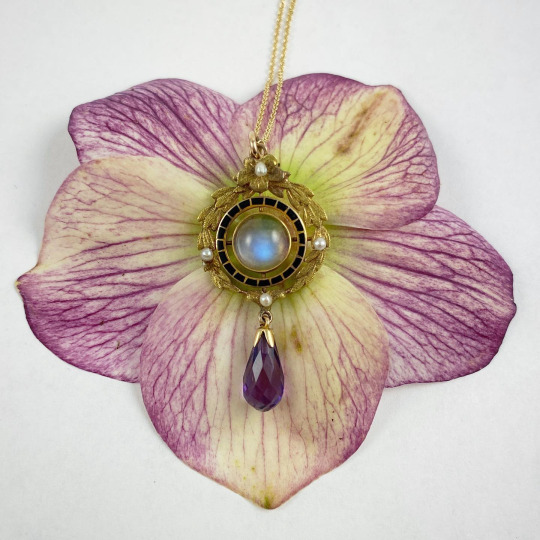
10k gold neo-classical pendant: A garland of gold leaves with tiny pearls containing a moonstone framed in black enamel, with a faceted teardrop amethyst pendant.
Maloy's
#antique jewelry#neo classical#art nouveau#amethsyt#moonstone#pearls#enamel#10k gold#pendant#historical jewelry#maloy's jewelry#portland#oregon
2K notes
·
View notes
Text

#i know i haven’t really done jewelry on the blog before#but omg i saw these and they are so FUCKING GORGEOUS that i couldn’t resist#hope y’all enjoy them as much as i do!! ☺️☺️#historical fashion polls#fashion poll#historical dress#historical fashion#dress history#fashion history#fashion plate#20th century fashion#early 20th century#20th century#1910s style#1910s dress#1910s fashion#circa 1910#1910s#1913#circa 1913#jewelry#historical jewelry
188 notes
·
View notes
Text
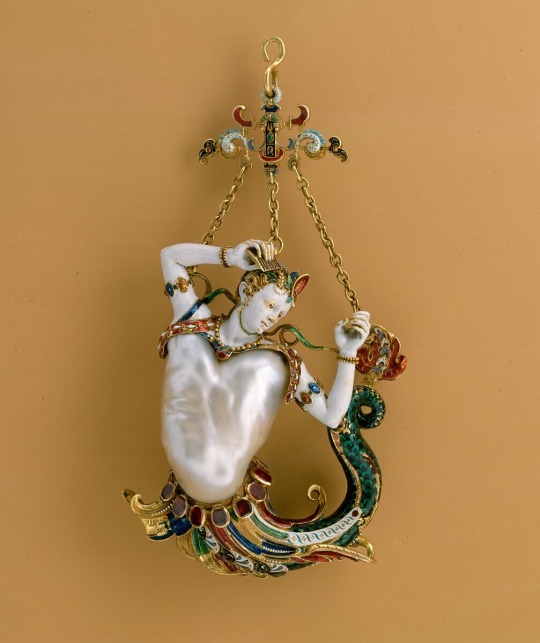
Pendant in the form of a siren, C. 1860
The Jack and Belle Linsky Collection, 1982
#mermaidcore#mermaid aesthetic#mermaids#sirens#1860s#19th century#historical fashion#historic fashion#historical jewelry#jewelry#history#vintage jewelry#unidentified maker#pendant
152 notes
·
View notes
Text

Historical garnet jewels from Perpinyà, Northern Catalonia. Photo by _clementt_ on Instagram.
Garnet is a gemstone that is used to make jewelry. It's a speciality in the Rosselló area (Northern Catalonia), whose artisans have been working with it for centuries.
The brightness of the deep dark red gemstone of Northern Catalan garnet jewels is achieved by adding a thin red sheet made of silver between the base and the gemstone. This innovation was added in the 19th century, and is still how the Northern Catalan garnet jewelers work.
These jewels are so iconic in Northern Catalonia that since the 19th century it has been considered a symbol of Catalan identity in Northern Catalonia.
#granat#catalunya nord#arts#jewelry#jewellery#gemstones#pays catalan#perpinyà#garnet#dark red#red#historical jewelry#northern catalonia#fashion#moda#historical fashion#folk fashion
281 notes
·
View notes
Text
In 1827, hair jewelry was nearing the height of its popularity. These pieces of jewelry featuring intricately woven hair of a loved one were worn in mourning or as friendship or love tokens by all genders. I like to believe Crowley and Aziraphale exchanged hair jewelry in Edinburgh that night.




#aziracrow#good omens#ineffable husbands#gomens#aziraphale#crowley#crowley x aziraphale#jewelry#good omens meta#hair jewelry#victorian#Georgian#historical jewelry
107 notes
·
View notes
Text



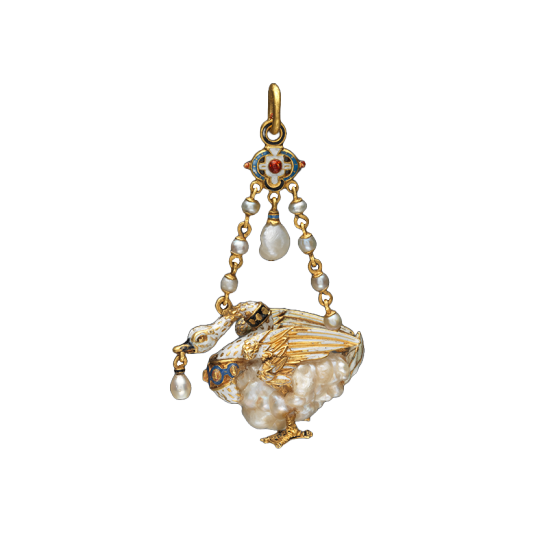

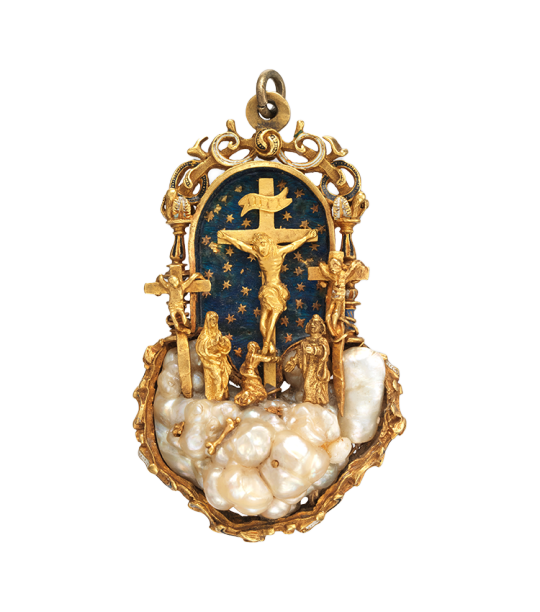
#art#art history#jewelry#historical jewelry#pendant#baroque pearl#baroque pearl pendant#renaissance style jewelry#renaissance style#italian renaissance#curios#curiosities#odds and ends#cabinet of curiosities#art academia#light academia#light aesthetic#light academia aesthetic#elegant aesthetic#intricate designs#ornate#pearl#jewels#precious gemstones#antiques#antiquities
716 notes
·
View notes
Text


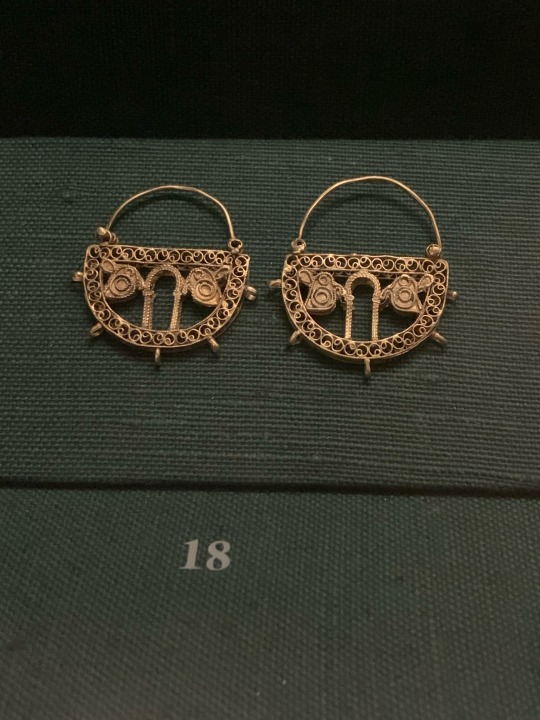
Byzantine-era earrings
Benaki Museum, Athens, Greece
#Byzantine#Medieval#museums#tagamemnon#Greece#jewelry#earrings#historical jewelry#historical fashion#Benaki Museum#Athens
71 notes
·
View notes
Text

The resolution isn't the best, but to the left is my ear, wearing my favourite pair of antique earrings, and to the left that of a lady of the early 18th century wearing earrings of a very similar design.
I was quite surprised to happen across earrings very much like mine in a painting, despite having seen photos of other currently extant pairs that look very similar online.
Perhaps it is the fact that she selected these exact earrings to be represented in her portrait, similar to me deciding that I wanted my picture taken wearing mine.
#i mainly buy antique jewellery bc they don't require new resources to be produced and bc they're of a more durable quality#even the costume jewellery of the 1910s will last longer than the costume jewellery of today#r rambles#historical jewelry#antique jewellery#18th century#18th century fashion#fashion history
21 notes
·
View notes
Text

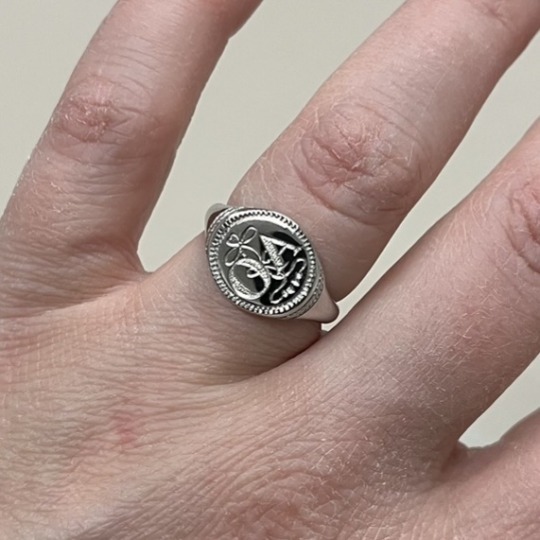


Thank you, Pragnell’s of Stratford-Upon-Avon, for agreeing to resurrect a historical replica design no longer in your catalogue in order to produce this special order! It took 6 months because they had to find an engraver experienced enough to execute it. I was kind of floored when they told me that’s why it took so long.
Yes, it’s nearly a direct replica of the artifact thought to be William Shakespeare’s signet. Yes, I totally had them replace the Bard’s initials with mine. I saw their gold version of this in person ca. 2011 and thought, I am going to have that one day, but I’m going to customize it. I’m including a photo of the actual artifact ring it’s imitating.
This and getting my grandmother’s diamond recut/reset were the 2 jewelry projects I always hoped to complete. I don’t take for granted the family members I lost last year who made these possible. I can’t wait to see if this actually functions as an effective wax seal!
74 notes
·
View notes
Text

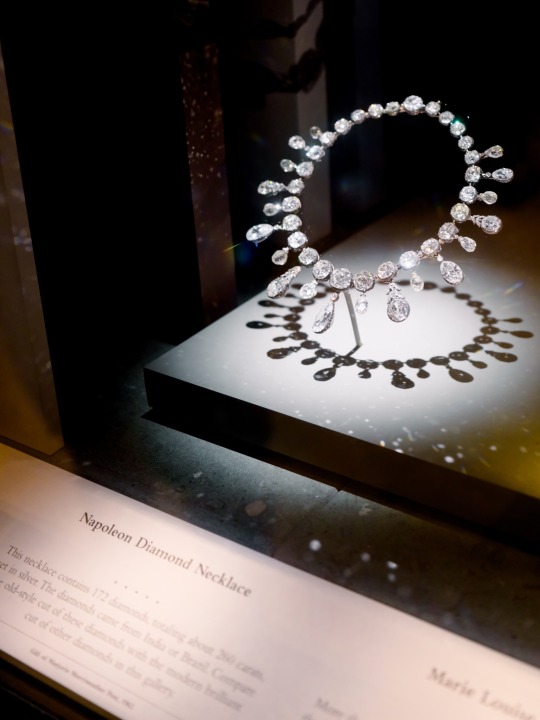
Two of my favorites from the gemstone section.
#personal#national museum of natural history#smithsonian#washington dc#photographers on tumblr#fine jewelry#historical jewelry
112 notes
·
View notes
Text

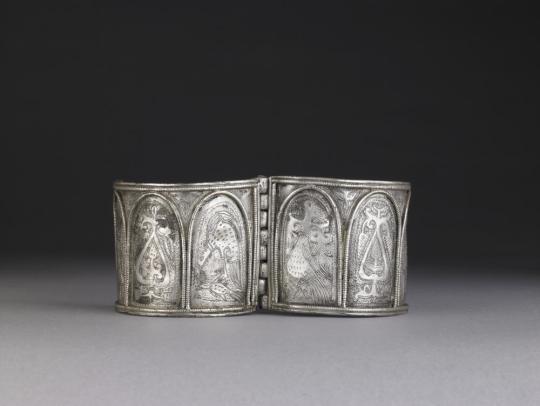
Silver armlet, Kievan Rus, 12th century AD
from The British Museum
#history#antiquities#art#medieval art#kievan rus#middle ages#jewelry#jewellery#medieval jewelry#historical jewelry
416 notes
·
View notes
Text

☘️💜 Circa 1900, 14k Art Nouveau pin/brooch, faceted amethyst heart, seed pearls, and enamel.
Maloy's
#historical jewelry#antique jewelry#art nouveau#heart jewelry#amethsyt#pearls#enamel#14k gold#brooch#maloy's jewelry#i love the different hue's of enamel#charming piece
169 notes
·
View notes
Text
I’ve been down a rabbit hole wondering about medieval jewelry (and if I can reproduce it despite having no metalworking skills, to which the answer is mostly no) lately & I figured I would share the fruits of my museum collection searches for other medievalists/hobbyists/reenactors/nerds.
Jewelry of the 13th Century Anglo/Francosphere

TL;DR
Metals: 🟨 gold(tone)
Stones: mostly 🔵 cabochon, rarely 💠 simple cut, some carved 🗿 intaglio or cameo
Stone Colors: warm blues, emerald green, purples, burgundies, reds
Materials: enamel, 💎 gemstones (garnet, Ceylon sapphire, ruby/spinel, emerald) or glass paste imitations, ⚪ semi-precious stones (pearl, lapis, jasper, carnelian, coral, turquoise, porphyry)
Settings: bezel (oval and rectangular); ⚜️ intricate metalwork; more visible and textured metal than modern jewelry; more mixtures of stones and colors than modern tastes
Motifs: ◯ round, ✤ quatrefoil, ✙ cross, ✸ star (even numbers of points), ♣ trefoil, ❦ floral, 🐉 animals, 𝕬 inscription
Formats: brooches, ornamented clothing, rings, pendants, circlets, cuffs (rare)
A detailed look:
Some forms of jewelry that were very popular in the Roman Empire and are again today were just not the thing in the middle European Middle Ages. (Earrings, for example, seem to have barely existed. This is partially at least because ears were covered--by coifs and caps, hair, and (for women) braids or the chin strap and fillet/wimple/gorget.) In fact, a lot of the places we would put jewelry against our skin today were covered.
This left some other options:
Jewelry on Clothing
Medallions
Okay, these aren’t jewelry, strictly speaking, but they’re metalwork ornaments associated with a person.
Enamel Mitre Medallions


OA 3437 and OA 3438
Before 1291, Ile de France
Louvre, Paris
photos (c) Musée du Louvre / Stéphane Maréchalle 2015
Cloisonné and plique enamel over gold and copper, with decorative motifs of trefoils, quatrefoil, and stars in a palette of dark blue and green with accents that may once have been ruby red.
Appliqué Medallion
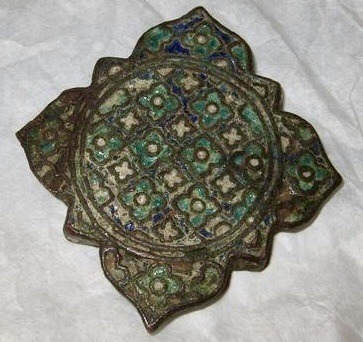
# MRR 256
13th c., Limoge
Louvre, Paris
photo (c) Musée du Louvre 2014
Gilded copper (though most gold is worn off) with quatrefoil champlevé enamel in emerald green, lapis blue, and white or off-white.
Brooches
Perhaps the most prevalent medieval jewelry item in the Anglo & French regions. These were worn at the shoulder for men and breast for women, often anchoring a cloak, or to close the collar. As the ornate fermail and double-ring brooch suggest, these ran the gamut from practical to incredibly decorative and ornate.
Garnet & Silver Gilt Animal Ring Brooch; Green and Blue Glass and Gilt Ring Brooch


Left, # 2003,0703.1
13th century; found in Suffolk, England
British Museum, London
photo (c) The Trustees of the British Museum
Right, # M.28-1929
13th c., England
V&A, London
photo © Victoria and Albert Museum, London
Cabochon garnets or carbuncles in the gilded silver brooch (L), perhaps once paired with smaller stones in the eyes of metalwork animals that bite the pin bracket. The right brooch, also silver gilt, sports two glass paste emerald and sapphire "gems" in cabochon. It was probably a lover's token; it reads (in Lombardic-lettered French) IOSV ICI ATI VCI or "jo su[i] ici a t[o]i v[o]ici" which I might translate as "I am here with/belonging to you, look!"
Ruby & Sapphire Ring Brooch; Sapphire, Garnet, and Pearl Fermail
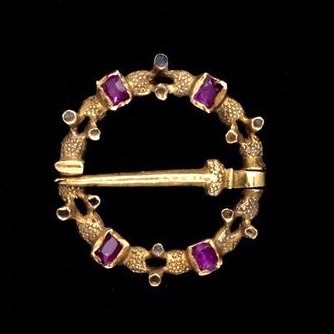
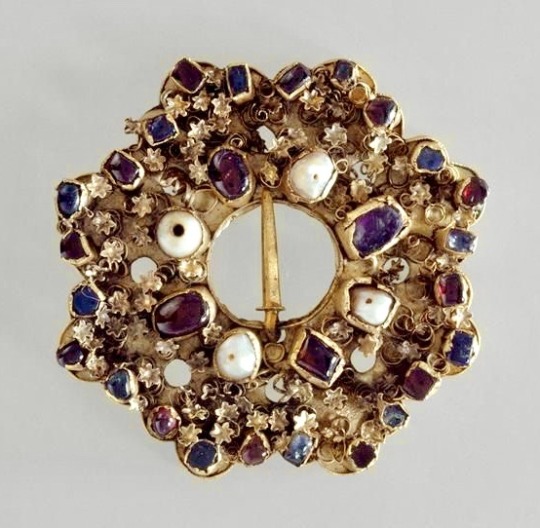
Left, # 6808-1860
1275-1300, England
V&A, London
photo © Victoria and Albert Museum, London
Right, # OA6287
1250-1300, France
Louvre, Paris
photo (c) Musée du Louvre
Blogs often claim that stones were only polished en cabochon until the 16th century, and that medieval jewelers couldn't cut gemstones. But this 13th-century gold ring brooch (left) pairs table-cut purple rubies with collet-set cabochon sapphires, and may evidence early medieval gem-cutting or reuse of Roman cut stones. The silver gilt fermail, right, includes pearl beads, garnets and sapphires both cut and cabbed, and one glass paste cabochon. Both are intricately textured, with punchwork (L) and floral metalwork, probably cast and then attached (R).
Double Ring Brooch with Sapphire and Glass "Emeralds"
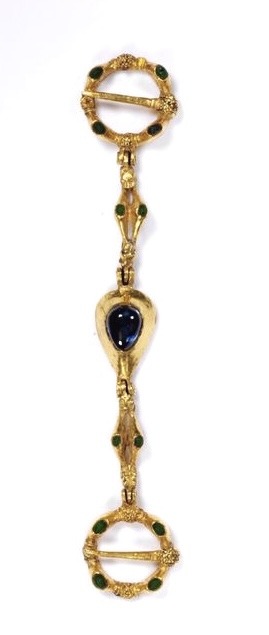
# M.26-1993
13th c., England
V&A, London
photo © Victoria and Albert Museum, London
This gold double brooch is so small they think it was for a woman or child. Central sapphire cab is flanked by glass paste "emeralds" in bezel settings and metalwork featuring two animal heads.
Jewelry on the Body
Rings
Many are probably familiar with the signet ring, used for pressing into sealing wax, which could be intaglio-carved gemstone or metals. There were also a number of decorative and/or talismanic gemstone rings.


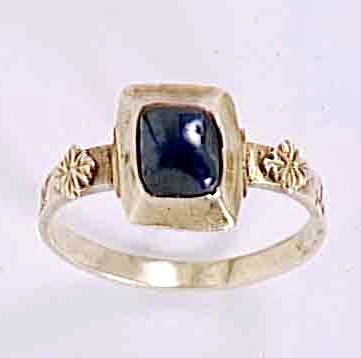
LtR:
#M.7-1929 | #M.180-1975 | #OA 11265
1250-1300, England | 1250-1300, Engl/France | 13th c., Engl/France
V&A, London | V&A, London | Louvre, France
photos L&C © Victoria and Albert Museum, London | R (c) Musée du Louvre
Sapphire in gold is the name of the game when it comes to rings in the thirteenth century; even the purple stones on the left are purple sapphires. (Sapphires were said to aid chastity, purity, and the effectiveness of prayer.) For larger stones, the bezel often has claws added (L); the central ring is an example of a full claw setting that modern viewers might find surprisingly tall. Naturalistic flourishes are added (C & R); these might be pre-cast then attached to the base (R).
Pendants
We equate pendants with necklaces, but their medieval applications also included wear as badges, from headpieces, and on horse decorations.


Left, bloodstone jasper cameo in silver setting
# MRR 218
1100-1300, France?
Louvre, Paris
photo (c) Musée du Louvre / Jean Blot 1984
Right, champlevé enamel, gilt copper, and paste "emerald" (harness) pendant
# 1976.169
13th c., France
Cleveland Museum of Art, Cleveland
photo CC0 Open Access
Statue Jewelry
From here, we get into the really ridiculous stuff; the previous categories could be relatively everyday (as much as ornamentation reserved exclusively for the wealthy can be an everyday thing) but the following examples are astonishing displays not necessarily for wear.
"La Couronne" de Vierge et l'Enfant d'ivoire de la Sainte-Chapelle

# OA 57 B
1250-1300, France
Louvre, Paris
photo (c) Musée de Louvre
This was not even a crown for a person, but rather for a painted ivory statue of the Virgin Mary, holding her infant son. (Though circlets, even set with stones, were sometimes worn as part of women's head dress.) It's incredibly ornate gold, set with pearls, garnets and rubies, sapphires, and turquoise (?) en cabochon.
Anneau de Saint-Denis




# MS 85 BIS
1200-1215, France
Louvre, Paris
photos (c) Musée du Louvre / Daniel Arnaudet 1990
This astonishing piece, which is ring-sized but now displayed as a cuff on an ivory hand, is made of gold and displays every possible gemstone appearance characteristic of the period. The front piece has a central sapphire and is surrounded by quartz with red backing (mimicking ruby/garnet), amethysts, pearls, and sapphires, some set on yellow backing (mimicking turquoise?). Most are en cabochon on this face, but two are faceted and two intaglio. Were this not enough, the three other 'faces' of the ring are set with gems as well, two cameos (probably sapphire and garnet?) and one amethyst intaglio set in ornate gold filigree.
#medieval#jewelry making#lapidary#history of fashion#historical jewelry#1200s#reenactment#England#France#enamel jewelry#ring brooch#fermail#intaglio#cameo#gemstones#infodumping#now time to go to the bead store#material history#you would think this is for my research or academically relevant but it's not I just couldn't stop looking at shiny things help#photos not mine#photos for educational purposes and not for commercial reproduction#louvre#v&a museum#british museum#cleveland museum of art
33 notes
·
View notes
Text

Mermaid Pendant, C. 1800-1857
Style of: Erasmus Hornick
#historical fashion#vintage jewelry#vintage fashion#fashion#historical#Erasmus hornick#unidentified maker#mermaids#mermaid core#mermaidcore#mermaid aesthetic#merfolk#19th century#1850s#vintage#pendant#historical jewelry
38 notes
·
View notes
Text
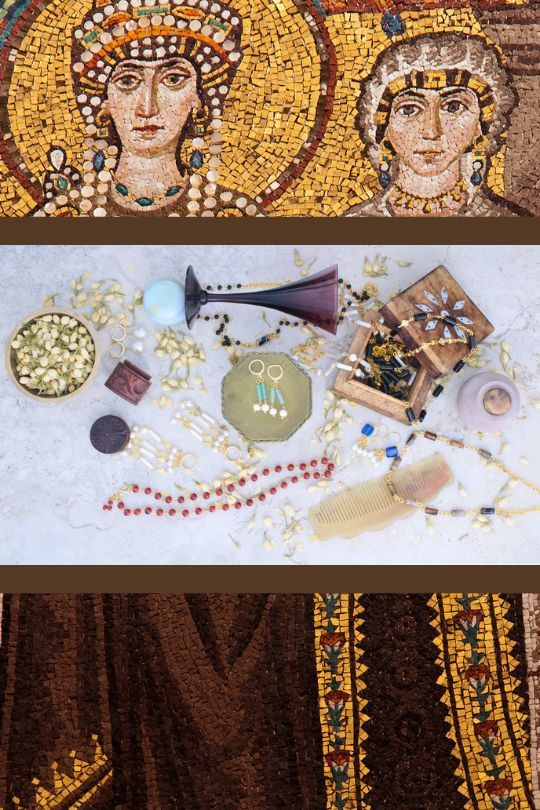

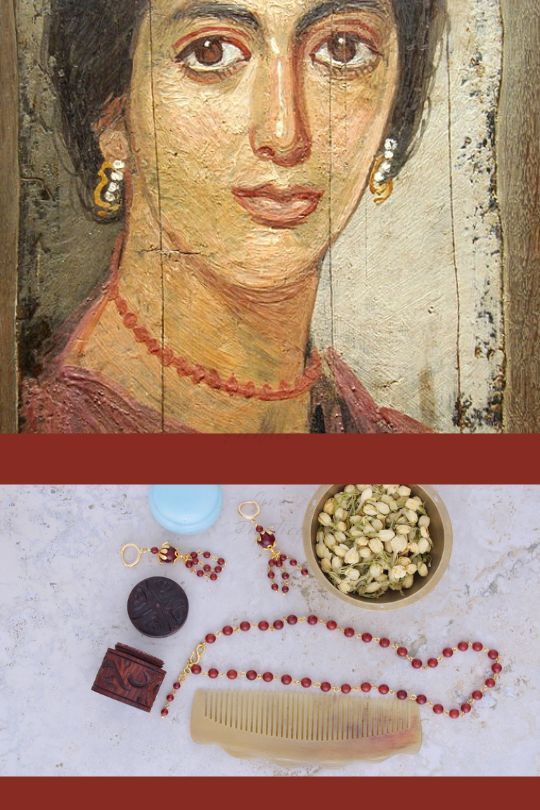


Late Roman and Byzantine inspired Jewelry by Iona Prentice.
13 notes
·
View notes